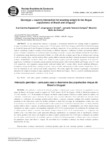Use este identificador para citar ou linkar para este item:
http://www.alice.cnptia.embrapa.br/alice/handle/doc/883143Registro completo de metadados
| Campo DC | Valor | Idioma |
|---|---|---|
| dc.contributor.author | ESPASANDIN, A. C. | pt_BR |
| dc.contributor.author | URIOSTE, J. I. | pt_BR |
| dc.contributor.author | CAMPOS, L. T. | pt_BR |
| dc.contributor.author | ALENCAR, M. M. de | pt_BR |
| dc.date.accessioned | 2011-04-10T11:11:11Z | pt_BR |
| dc.date.available | 2011-04-10T11:11:11Z | pt_BR |
| dc.date.created | 2011-03-28 | pt_BR |
| dc.date.issued | 2011 | pt_BR |
| dc.identifier.citation | Revista Brasileira de Zootecnia, v. 40, n. 3, p. 568-574, mar. 2011. | pt_BR |
| dc.identifier.uri | http://www.alice.cnptia.embrapa.br/alice/handle/doc/883143 | pt_BR |
| dc.description | It was analyzed the existence of genotype × environment interaction for weaning weight in populations of Angus from Brazil and Uruguay by using records of 73,205 animals (10,257 from Uruguay and 62,948 from Brazil) belonging to 33 and 161 farms and 13 and 34 regions in Uruguay and Brazil, respectively. It was used the one- and two-trait animal model analyses considering weight at weaning of each country as different characters. Coefficients of direct and maternal additive-genetic correlation estimated by two statistical models (including or not bull × country effect) Models included the fixed effects of contemporary group (herd-year and month of birth), sex of the calf, the covariates age of dam at calving (years) and age of calf at weaning (days), and the random effects genetic-additive maternal and direct, maternal permanent environment and residual. Herdabilidades (of direct effect) were similar in both countries and with moderate magnitude (0.35 and 0.15, respectively). Coeficients of correlation among maternal and direct genetic effects between Brazil and Uruguay were 0.77 and 0.13, respectively, and comparison among models (with and without bull × country effect) showed significant differences. Correlations among classifications (ranking of genetic values) of bulls with progenie in both countries ranged from 0.35 to 0.41 for estimations in one- and two-trait models, respectively. The results suggest the existence of genotype × environment interaction for weight at weaning of Angus populations between Brazil and Uruguay. There is a need of considering interaction in further international genetic evaluations of the breed. | pt_BR |
| dc.language.iso | eng | pt_BR |
| dc.rights | openAccess | pt_BR |
| dc.subject | Genotype × environment interaction | pt_BR |
| dc.subject | International evaluation | pt_BR |
| dc.subject | Correlação genética | pt_BR |
| dc.subject | Interação | pt_BR |
| dc.title | Genotype × country interaction for weaning weight in the Angus populations of Brazil and Uruguay. | pt_BR |
| dc.type | Artigo de periódico | pt_BR |
| dc.date.updated | 2012-05-04T11:11:11Z | pt_BR |
| dc.subject.thesagro | Genótipo | pt_BR |
| dc.subject.thesagro | Gado de Corte | pt_BR |
| dc.subject.nalthesaurus | genetic correlation | pt_BR |
| dc.subject.nalthesaurus | beef cattle | pt_BR |
| riaa.ainfo.id | 883143 | pt_BR |
| riaa.ainfo.lastupdate | 2012-05-04 | pt_BR |
| dc.identifier.doi | https://doi.org/10.1590/S1516-35982011000300014 | eng |
| dc.contributor.institution | ANA CAROLINA ESPASANDIN, FACULTAD DE AGRONOMIA- EEMAC-UDELAR URUGUAY | pt_BR |
| dc.contributor.institution | JORGE IGNACIO URIOSTE, FACULTAD DE AGRONOMIA- EEMAC-UDELAR URUGUAY | eng |
| dc.contributor.institution | LEONARDO TALAVERA CAMPOS, UNIVERSIDADE FEDERAL DE PELOTAS | eng |
| dc.contributor.institution | MAURICIO MELLO DE ALENCAR, CPPSE. | eng |
| Aparece nas coleções: | Artigo em periódico indexado (CPPSE)  | |
Arquivos associados a este item:
| Arquivo | Descrição | Tamanho | Formato | |
|---|---|---|---|---|
| 1130.pdf | 111,9 kB | Adobe PDF |  Visualizar/Abrir |









